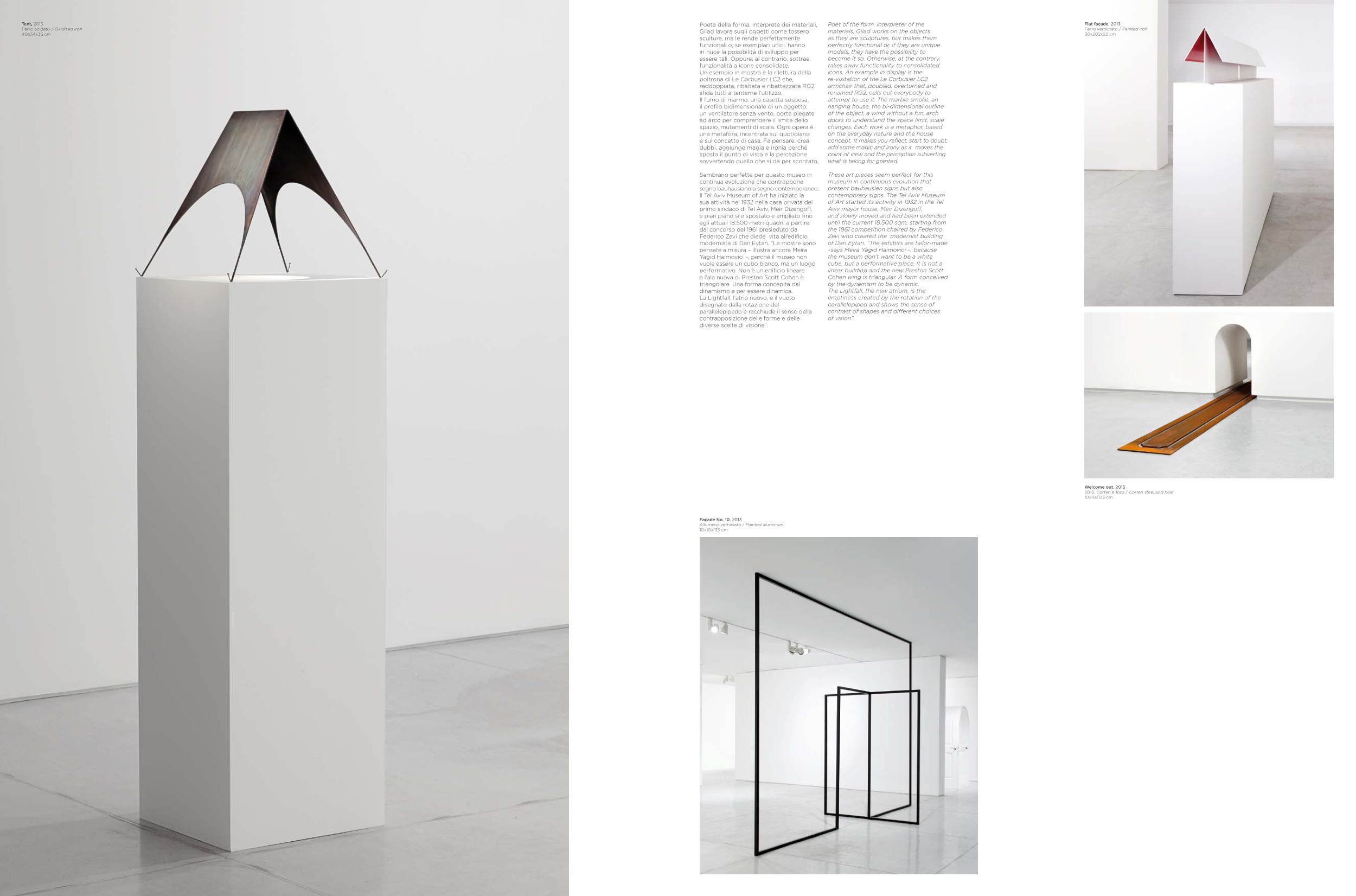Welcome out, 2013
2013, Corten e foro / Corten steel and hole
10x10x133 cm
Façade No. 10, 2013
Alluminio verniciato / Painted aluminum
10x10x133 cm
Tent, 2013
Ferro acidato / Oxidised iron
40x34x35 cm
Flat façade, 2013
Ferro verniciato / Painted iron
30x202x22 cm
Poeta della forma, interprete dei materiali,
Gilad lavora sugli oggetti come fossero
sculture, ma le rende perfettamente
funzionali o, se esemplari unici, hanno
in nuce la possibilità di sviluppo per
essere tali. Oppure, al contrario, sottrae
funzionalità a icone consolidate.
Un esempio in mostra è la rilettura della
poltrona di Le Corbusier LC2 che,
raddoppiata, ribaltata e ribattezzata RG2,
sfida tutti a tentarne l’utilizzo.
Il fumo di marmo, una casetta sospesa,
il profilo bidimensionale di un oggetto,
un ventilatore senza vento, porte piegate
ad arco per comprendere il limite dello
spazio, mutamenti di scala. Ogni opera è
una metafora, incentrata sul quotidiano
e sul concetto di casa. Fa pensare, crea
dubbi, aggiunge magia e ironia perché
sposta il punto di vista e la percezione
sovvertendo quello che si dà per scontato.
Sembrano perfette per questo museo in
continua evoluzione che contrappone
segno bauhausiano a segno contemporaneo.
Il Tel Aviv Museum of Art ha iniziato la
sua attività nel 1932 nella casa privata del
primo sindaco di Tel Aviv, Meir Dizengoff,
e pian piano si è spostato e ampliato fino
agli attuali 18.500 metri quadri, a partire
dal concorso del 1961 presieduto da
Federico Zevi che diede vita all’edificio
modernista di Dan Eytan. “Le mostre sono
pensate a misura – illustra ancora Meira
Yagid Haimovici –, perché il museo non
vuole essere un cubo bianco, ma un luogo
performativo. Non è un edificio lineare
e l’ala nuova di Preston Scott Cohen è
triangolare. Una forma concepita dal
dinamismo e per essere dinamica.
La Lightfall, l’atrio nuovo, è il vuoto
disegnato dalla rotazione del
parallelepipedo e racchiude il senso della
contrapposizione delle forme e delle
diverse scelte di visione”.
Poet of the form, interpreter of the
materials, Gilad works on the objects
as they are sculptures, but makes them
perfectly functional or, if they are unique
models, they have the possibility to
become it so. Otherwise, at the contrary,
takes away functionality to consolidated
icons. An example in display is the
re-visitation of the Le Corbusier LC2
armchair that, doubled, overturned and
renamed RG2, calls out everybody to
attempt to use it. The marble smoke, an
hanging house, the bi-dimensional outline
of the object, a wind without a fun, arch
doors to understand the space limit, scale
changes. Each work is a metaphor, based
on the everyday nature and the house
concept. It makes you reflect, start to doubt,
add some magic and irony as it moves the
point of view and the perception subverting
what is taking for granted.
These art pieces seem perfect for this
museum in continuous evolution that
present bauhausian signs but also
contemporary signs. The Tel Aviv Museum
of Art started its activity in 1932 in the Tel
Aviv mayor house, Meir Dizengoff,
and slowly moved and had been extended
until the current 18.500 sqm, starting from
the 1961 competition chaired by Federico
Zevi who created the modernist building
of Dan Eytan. “The exhibits are tailor-made
–says Meira Yagid Haimovici –, because
the museum don’t want to be a white
cube, but a performative place. It is not a
linear building and the new Preston Scott
Cohen wing is triangular. A form conceived
by the dynamism to be dynamic.
The Lightfall, the new atrium, is the
emptiness created by the rotation of the
parallelepiped and shows the sense of
contrast of shapes and different choices
of vision”.


